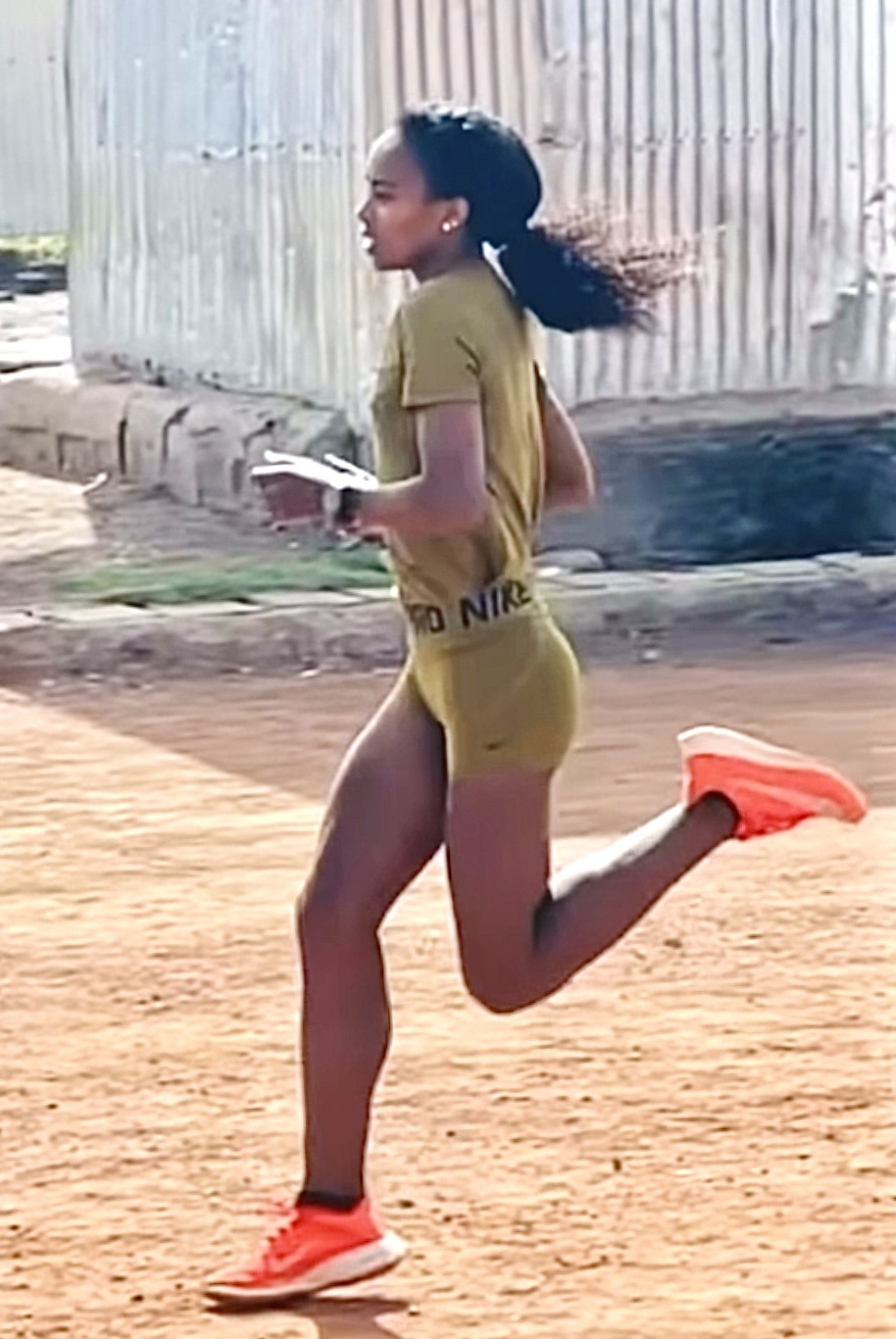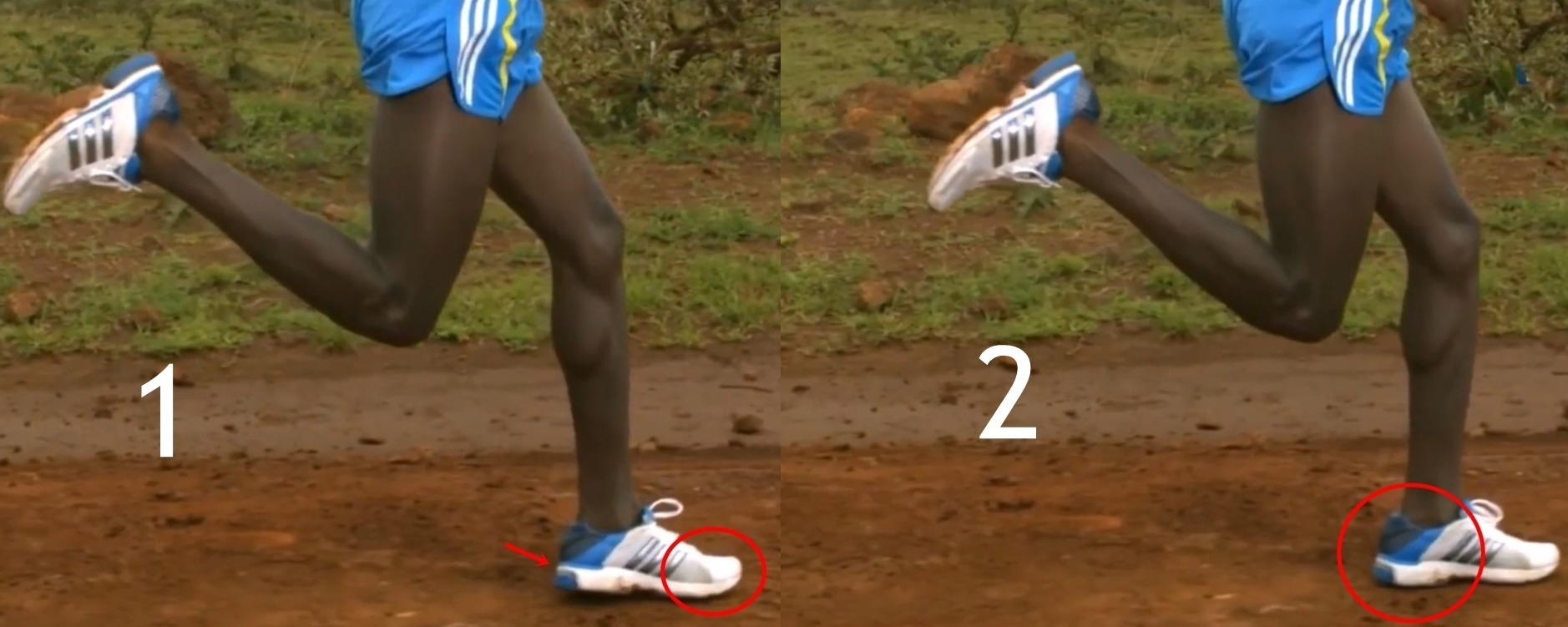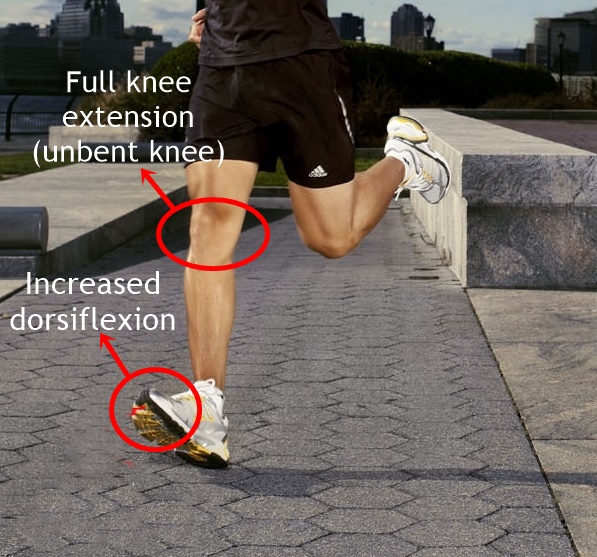One way forefoot running is faster than heel strike running is that its more energy efficient because it enables significantly more energy-saving elastic power in the Achilles tendon!


It turns out that forefoot striking during running naturally engages certain mechanical components that enables the Achilles tendon to store more elastic energy which is an asset for better running economy because it lowers muscle energy costs! These mechanical components engaged by landing forefoot-first when running are: increased plantar-flexion and increased knee flexion (knee bending) at landing, followed by the heel-lowering phase shortly after the forefoot strikes the ground, shown below:

The prevailing notion is that increased plantar-flexion and knee flexion prior to and at touchdown as well as heel-dropping shortly after the forefoot strikes the ground when running, slackens the Achilles under low-impact conditions. This is not only more protective on the Achilles, but it optimizes the tendons capacity to store more elastic energy since it slackens closer to the centre of mass, thereby enhancing the mass-on-a-spring-effect.
In heel strike running, prior to and at landing, the opposite mechanical movements at the lower leg occurs (shown below) in that the foot is dorsiflexed, meaning the front of the foot lifts up. Meanwhile, the knee-joint of the landing foot completely unbends (full knee extension), all of which produces greater net forces and hyper-stretches the Achilles.

Landing this way positions the Achilles tendon farther away from the center of mass, while causing the tendon hyper-stretch at heel strike under high impact conditions. In consequence, the Achilles tenodn not only endures more impact stress, but the mass-on-a-spring effect is diminished since the tendon is less able to slacken under the center of mass. This is why the Achilles tendon is less spring-loaded in heel strike running than in forefoot running!
Furthermore, when a stride is less spring-enabled (like in heel strike running) results in extra muscle energy costs because greater muscle response and power is needed to counter the loss of spring. Put differently, if the spring structures in the lower leg are more offline, the muscles need to work harder to propel the body forward.
The take home message is it’s becoming very evident that foot strike definitely matters in running, not just from an injury standpoint, but a performance standpoint as well. Landing heel-first when running seems to alter certain economical parameters that causes the Achilles to be an ineffectual spring whereas landing forefoot-first has shown more promise in engaging certain mechanics that helps support the natural functionality of the Achilles.

References:
Bishop M, Fiolkowski P, Conrad B, Brunt D, Horodyski M. Athletic footwear, leg stiffness, and running kinematics. J Athl Train. 2006;41:387–92.
Ker RF, Bennett MB, Bibby SR. Kester RC, Alexander RM. The spring of the arch of the human foot. Nature. 1987;325:147–9.
Lieberman DE, Venkadesan M, Werbel WA, et al. Foot strike patterns and collision forces in habitually barefoot versus shod runners. Nature. 2010;463:531–5.
Nigg B. Biomechanics of Running Shoes. Champaign (IL): Human Kinetics. 1986;p. 180.
If you’ve enjoyed this article, you’ll love my content over at my YouTube channel, here, where I go into more detail about the evidenced-based facts on the performance and injury preventative advantages of forefoot running vs heel strike running.
If you’d like, you can show support and help keep Run Forefoot going by making a donation in any amount of your choosing:

Or, you can also support Run Forefoot by shopping at the following top minimalist shoes brands, and be sure to bookmark the links:
Vivobarefoot: https://shrsl.com/3kvih
Be Lenka: https://www.dpbolvw.net/click-7600968-14330828
FeelGrounds: https://www.feelgrounds.com/?p=RunForefoot
Xero Shoes: https://xeroshoes.com/go/Run_Forefoot
Iguaneye: https://www.iguaneye.com/?ref=8tfXVc92
Soft Star Shoes: https://shrsl.com/3mp1b
Wilding Shoes: https://bit.ly/3lIygQP
Zappos: https://goo.gl/J1CeAd
Bretta Riches
BSc Neurobiology; MSc Biomechanics candidate, ultra minimalist runner & founder of RunForefoot. I was a heel striker, always injured. I was inspired by the great Tirunesh Dibaba to try forefoot running. Now, I'm injury free. This is why I launched Run Forefoot, to advocate the health & performance benefits of forefoot running and to raise awareness on the dangers of heel striking, because the world needs to know.
Latest posts by Bretta Riches (see all)
- Does Foot Strike Really Matter in Running? YES! - 17/04/2024
- Heel Lifts Increase Injury in Runners - 16/04/2024
- Are Minimalist Shoes Good for Seniors? YES! - 14/04/2024
